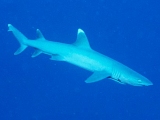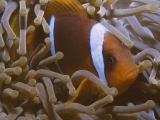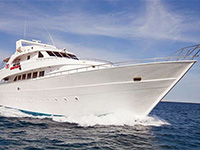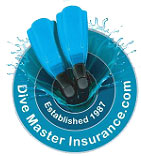Quality Diving at Budget Prices on a Great Barrier Reef Live Aboard
This article was contributed by Tab Hauser, a freelance writer and photographer.
Different thoughts come to mind when one thinks of diving on the Great Barrier Reef in Australia. These can include not only the sight of pristine coral reef systems along with a multitude of sea life but also the time and expense that goes with such a trip. For the "average" tourist vacationing in Australia the highlights include places like Sydney, Ayers Rock, the Queensland Rainforest and Cairns to name a few. Cairns (pronounced Cannes) was one of the destinations we recently visited on a family trip in Australia. This water town is major jumping off point for seeing the world's largest living object, the Great Barrier Reef. Many non-divers and some casual divers with limited time or who are on a bus tour use Cairns as the jump off point for a day trip. These day trips take all morning on a quick boat holding as many as 300 people to get to the outer reef. (There is a helicopter option) They spend the day snorkeling or doing a couple of dives before heading back on the long ride to Cairns. By doing this you get the most basic flavor of the Great Barrier Reef as you visit only one spot. Many people also take a day boat to one of the islands on the inner reef not far from Cairns. While this can be nice, the inner reefs are not in the same league as the outer reefs in terms of condition and clarity.
Our family decided we wanted to get more out of the reef than simply hopping on a fast day boat to the outer reef or visiting a place on the inner reef. With the help of the internet I found a live-aboard dive boat called the Taka II.
The Dives • The Liveaboard • Getting There
The Dives
Cod Hole
Our first two dives were at Cod Hole. The maximum depth of this dive was 100 feet to a sandy ledge. You would then make your way around some coral ridges and bommes to a coral wall that went up to within four feet of the surface. Larger fish we saw here included Potato and Camouflage Cod, Trigger Fish, Maori Wrasse, Coral Trout, jacks and snapper. The coral here was in pristine condition. The second dive was also here about an hour later but this time it was to watch the dive masters feed the 200 pound cod we saw. (It should be noted that what they call large cod here would be similar to what Americans call large groupers.) On this dive we were requested to swim out to the sandy feeding area as quickly as we could and lie still while the dive master did a controlled feeding. We were told that feedings were permitted by park officials as long as it was no more than about 2 pounds per day. The reasoning was that the fish would still have to hunt on their own and not be totally dependent on the divers.
Challenger Bay

The third dive this morning was at Challenger Bay. Challenger Bay was another beautiful dive that started at about 60 feet and again worked its way up around a few coral bommes until you reached a pure coral wall that went straight up to about four feet. Each piece of coral was laid out beautifully next to one another. Here we saw lionfish, garden eels, tangs and a school of barracudas. The bottom time allowed for this dive was 45 minutes. This was also the same place that we did our night dive. My 13 year old son Daniel with a total only of six dives under his belt decided to try his first night dive at Challenger Bay. Here he spotted the large jacks and snappers chasing after the fish that left the safety of the reef. The hunting for these small fish was made even easier to the big fish anytime a diver put their flash light on small fish. The land analogy would be like blinding a deer with your headlights. Daniel also was excited when he spotted two five foot white tipped reef sharks in separate areas.
Riboon Reefs

On our second day they had us do three dives before lunch. The first one was at place between the 10th and 9th ribbon reef called Steve's Bommie. This was a large coral bomme starting at about 100 feet and making a cone type shape until it reaches about 10 feet from the surfaces. Our ship literally stopped in the middle of what seemed to be open ocean between the ribbon reefs to dive here. Next to Steve's Bomme was a memorial plaque to Steve himself who is said to have dived this particular place often before he died. Depending on who you talked to, his death was either a motorcycle accident or a free dive accident. The next dive was on Temple of Doom. This was more of a plateau type coral structure starting at 100 feet and making its way to a flat area about 9 feet under water. It took about 45 minutes to circle the reef where we kept our depth between 40 and 60 feet. This site had more fish life than some of the other places we visited because of the way the very slow current comes by with the needed nutrients. One note on the lighter side is that during the dive briefing we were advised we really can "Find Nemo" here. What we saw in the middle of the plateau in about 10 feet of water was an anemone about one and half times the size of a basketball with the small center opened about 12 inches protecting three small, very cute, clown fish. I have seen films and pictures of clown fish swimming in and out of their protective environment and it was neat to see it up close and personal. The last dive this morning was called Clam Gardens. As the name states, this place is known for the large clams famous in this part of the world. We saw calms ranging from 3 to 6 feet long with different colors on the inside. The varied coloring was attributed to a type of algae that grows under the skin. What I liked about this reef was the diversity of the area. Because the dive briefings were so detailed, we were able to navigate around the bommes in the area and eventually make it to one of the most colorful sun drenched coral walls I have ever seen.
At 1PM all divers were up on board and at 1:30 lunch was served to some very hungry guests and staff. One routine that did not change during the trip was a "quiet time"" that takes place on the TAKA II after lunch. People either headed to their cabins for a long afternoon snooze or back to salon to write in their dive log books and watch a movie. The salon couches and floor with pillows was also where the crew would take their well deserved afternoon nap.
Beer Gardens
After a 3 hour steam the boat stopped for a night dive at reef called Beer Gardens. We were told the name comes from this being the last night of the 3 night cruise and people celebrating with a beer or two. Seriously though, this is the place to see sleeping turtles.
Hog's Beach
After dinner we left Beer Gardens to rock and roll for about an hour while the TAKA II steamed outside the reef to a protected place for the night called Hog's Breath. It was here that we did our 6:15AM dive briefing followed by a 6:30AM dive. Breakfast was at 7:30 and the second and last dive for the trip was at 8:30 at a nearby reef called No Name Bomme. This was our final dive and I have to say I did not miss the smell and feel of wet neoprene in the morning after this. After the crew allowed time for showers and lunch we were off to Cairns. Another "budget" feature of the TAKA II was that all passengers had to be out of their cabin by 12:30. Rather than be allowed to nap in our cabins, we were advised that the entire crew from dive master to deck hand actually works to ready the boat for a quick turn around. This meant that we spent the 5 hour cruise back to town either on deck or in the salon.
The Liveaboard
The TAKA II is 100 feet long with a beam of 30 feet. It has a draft of 11.5 feet and cruises at 11 knots with a range of 5000 nautical miles. While the boat was at full capacity during our trip it never felt overcrowded, even at meals or when all of us were gearing up and diving at the same time. The TAKA II, as one dive master said on board, is a "diver's ship" and not a luxury cruise boat. It does not have lots of frills and the prices reflect this. The least expensive category to sleep in was the lowest deck. Here you get a bunk with three others to share your dive experience at a price of $900 Australian. There are no windows in the lower cabins and the heads and showers are shared one level up. This level can also be a bit noisy, because you are closer to the engine. The more expensive cabins are on the top deck and range from two single bunk beds to a single bed over a twin bed. One cabin they call the honeymoon suite had a queen bed and extra couch to store things on. The upstairs cabins come with a small TV with DVD player. The honeymoon cabin also has X-player game unit. The upstairs cabins all had windows and private bathrooms. Prices upstairs are $1125 to $1300 per person. With the Australian dollar trading at about 25% less than the U.S. dollar there are some real values attained here.
The food served on board was basic. Meals were prepared during our cruise by a Swiss gentleman. He stuck to simple fare that was tasty and filling. The three dinners during our trip included roasted chicken legs done two ways, fish prepared two ways and on the last night, pasta cooked with three sauces on the side. Each dinner was served with salads, steamed vegetables, soup and rolls. Breakfast was eggs, meat, fruit, yogurt and cereal. Lunch included cold cuts or a hot dish, soup and salads. There was always fruit and snacks after each dive. Cold beer, soda, bottled water, and candy bars were available at very reasonable prices. All meals were buffet style. The guests ate first, followed by the crew. Complaints about the food among the various guests included having to drink only instant coffee as well as being served pasta for dinner and then again for lunch the next day. A few people thought having packaged baked goods for desert was wasted calories. To keep costs of labor on the boat down, guests were requested to clear their own plates, wiping food into one box and dropping the used utensils in the other. All meals were in the large salon on the first level. While the salon was comfortable and roomy to fit everyone, it missed having windows overlooking the ocean. They tried to make up for this design blunder by having two large flat screen plasma TV's on each side attached to cameras on the bow and stern. This "outside" viewing was turned off during movies as well as at night. When asked why there were no windows, a crew member told me it would have cost more to design the ship with windows. I thought this was a poor choice when building a boat.
As mentioned, the TAKA II is a "divers boat". While the Taka II lacks certain on- board amenities, it more than makes up for this on service for the dives. The people here are dedicated to their guests, the reef and the sport of diving. Extra service was given to the new divers as well as any guest needing extra help. First, they helped my wife, who has some back trouble, with her tanks on every dive by bringing them to a lower platform so she can shove off from a sitting position rather than taking a giant stride. By the third dive they were there to help her before she was even ready. They were also great with the new divers (my son included) and took them on a guided trip out on their first dive to make them feel comfortable. On all dives there was the option to be guided or go on your own. A better-staffed boat would be hard to find.
The TAKA II was so perfectly set up for diving that 28 people could all suit up and jump in without anyone bumping into anyone else. One way they did this was that was that each guest had their own spot on the dive deck for the week. Each place had a large basket under the bench to store your weight belt, mask and fins. The smartest thing they do here to speed things up and make life easy on the diver is to keep the BCD's always attached to the same tank. During the 10 dives I never had to remove my BCD and change tanks. After each dive, we unscrewed our first stage, letting them know we were low on air. The staff would simply refill the tank at your station and reattach the first stage. For the photographers on the boat, there were three large buckets of fresh water set aside for cameras.
As with all dive boats, safety was a primary concern. Detailed briefings were done on the aft section of the boat under the shade. No beer or wine was sold during diving hours and there were usually two people to see you off. One person was there to make sure your air was on, the other to log in your time leaving. Upon returning to the boat, you were also checked in and your depth and bottom time was recorded. At the end of the week all the lists were posted. This way you could see at a glance your depth and bottom times and double check what you may have entered in a dive log.
The TAKA II runs out of Cairns twice a week. On Tuesday they depart for Cod Hole and Northern Great Barrier Reef, a three day trip. On Fridays they do more or less the same trip but spend an extra day going to and from the Coral Sea. My family opted to do the three-day trip due to time limitations and concern about rough seas on the open oceans going to the Coral Sea. Trips board at 5PM and travel overnight, reaching the famous Cod Hole in the morning. From there you move south finishing on your last day with two very early morning dives on the inner reef. On our trip there was a total of eight day dives and two night dives.
The crew allows for a lot of dive freedom. Most dives give you a bottom time of 50 minutes and they request you come up with 50 bar or 750 psi. While they requested this rule and warned you that you can be barred from a dive if you come up too short on air they were not crazy about this. I normally came up with 400 to 500 psi and no one seemed to complain or take note of it. They did have one rule that they were very serious about. No one was allowed to bring anything up from the reef. At the first briefing one dive master said that the crew will radio the authorities to report any diver that does not heed this law and that the fine can be $A60,000.
Getting There
Most major airlines fly into Cairns with a stop in Sydney. It should be noted that Cairns is also only 90 minutes by car from the famous beaches and rainforest of Queensland and the two areas can be easily combined in one trip. One last important detail has to deal with anyone that has a tendency of getting seasick. The weather conditions can make the ship rock and roll a bit especially when they travel out side the reef. If you are prone to seasickness I recommend getting a prescription from your doctor for the medicine that is built into the small patch that stays behind your ear. This kept my son and me in good shape for the first and last night. We found they stuck very well behind our ears even after 2 days of diving.
Overall we found the TAKA II and the Great Barrier Reef to be a wonderful experience. This boat and the dives we were on were ideal for any diver whether you were a novice or experienced.
By Tab Hauser.
Further Reading
- Diving Australia: A Guide to the Best Diving Down Under
- by Neville Coleman, Paperback, PeriPlus Editions, 332 pages (2004)
- Atlas of Australian Dive Sites
- by Keith Kockton, Paperback, HarperCollins, 288 pages, (2003)
Buy from Amazon.co.uk
Buy with free worldwide delivery
Comments
Send us your comments on this article, diving in Australia or anything else on the SCUBA Travel site.



